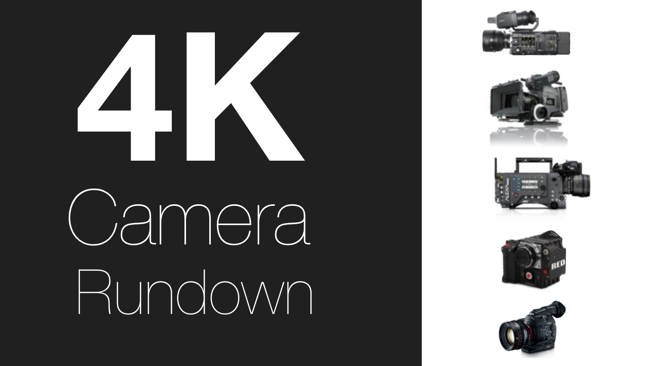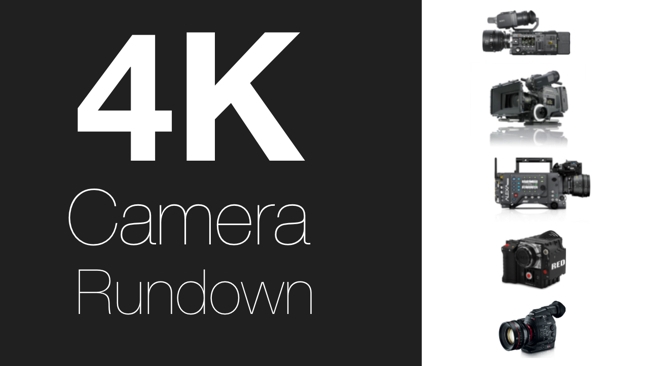
 4K camera rundown
4K camera rundown
In between IBC and NAB, most of the newly-announced 4K cameras are on sale. So before the expected avalanche of 4K announcements and previews at NAB, we thought we'd ask Phil Rhodes to run though what you can buy now
We seem to live in a world where progress is defined by ever-rising numbers, from the few dozen lines of early mechanical TV, through 405, 625 and 1080 line formats. (Don’t forget the old French monochrome 819 line system - Ed.) The number of the day now appears to be “4”, or rather 4000. Despite all the fuss that's been made about this, though, cameras significantly exceeding HD resolution actually go back almost ten years, to Dalsa's announcement of the Origin camera at NAB 2003. I could – and in the past have – gone on for hundreds and hundreds of words about the relative usefulness of 4K, given that the cinema audience is habituated to images that almost never exceed half that on the screen. We could discuss the dubious imaging capability of some fixed-lens attempts at 4K, or we could equivocate over the signal-to-noise ratio that will ever be achievable with sensors 4000 photosites wide that are no bigger than a film frame.
We should be originating at 4K
But ultimately, we really should be originating at a resolution higher than we distribute, if only to make our own lives easier by providing a little wiggle room for focus, framing, stabilisation and visual effects. Happily, that's rarely been easier. So here’s a quick rundown on what's actually available. This is, as far as I'm aware, a complete list of the people who currently offer cameras with sensors at or approaching 4000 photosites wide, capable of shooting at sync-sound rates (so no GoPro, which only does 4K at a dozen or so frames per second).
Red
With 5K-wide sensors, Red are now probably capable of creating frames significantly exceeding HD resolution that aren't too noisy. What's most important about Red, though, is that they were among the first to propose, and certainly the first to popularise, the idea of debayering images and doing critical basic corrections outside the camera. While this was of course sold to us as a workflow innovation, what it actually meant was that there was an enormous amount of electronics that they didn't have to design, manufacture, and power. Comparatively few manufacturers absolutely require this workflow now – and the Epics have realtime HD outputs that are somewhat usable – but many offer it as an option. I hope that the company will now be happy with its resolution supremacy, and start to work on matching Alexa's superb highlight handling. Perhaps they will with their much-trailed Dragon Sensor.
Canon
The C500, shipping since October last yer, is particularly interesting because of what it tells us about the C300, but as a 4K camera I'm afraid I haven't seen enough of it to tell whether that motion picture sensor of Canon's is really as good as C300's downscaled output made it look. If C500 is a 4K version of C300 with no other caveats, then it is superb. The raw offboard 4K option or the onboard flash card option mirror Arri's effort as, hopefully, do the pictures. It's also made by a company that, regardless of a few eyebrow-raising feature choices on the original 5D Mk. II, which I suspect they'll be living down for a decade, has a reassuring history of making stuff that works and keeps working.
The problem with the Canon EOS Cinema series is the odd form factor, which telegraphs the company's roots as a DSLR manufacturer. I suspect it will work fine, or at least be made to work fine, in dramatic production where offboard monitoring is the norm, but I get the impression that it's going mainly for the world of documentary and that centralised viewfinder, well, could be more ideal. Even further from the film camera ethos, but still capable of quality 4K images is the Canon 1-D C: a DSLR that records 4K images in the pretty much universally accepted MJPEG format.
Sony
Sony now has a range of 4K output-capable cameras, starting with the F700 when it is equipped with a $6,300 AXS-R5 Raw Recorder. F65 is an excellent device of well-known capability and I suspect will continue to be at the top of the field for some time to come, so what's really interesting – unless you're an FS700 owner with a burning need for 4K – is the upcoming 5-series stuff. Sony have eaten a very well-filled sensible sandwich on the general design and layout, although I'm slightly less convinced by the introduction of yet another flash card format, especially as recently-released prices put AXS cards at $2100 for 512GB, comfortably five times the price of a conventional SSD. I suspect in any case this may be self-resolving as people may slap other recorders on it.
The prices put the new Sony gear somewhere just above Red and a lot below Alexa, although all three will need additional hardware to create a usable package. This seems pretty fair, given that (and this is of course a prediction) it's likely to be better than Red and doesn't quite have the cachet of Arri, but I do wonder slightly who would buy an F5 and the 4K recorder pack, as opposed to just buying an F55 for not, in context, that much more money. This presumably also heralds the demise, or possibly in the short term the reduction in price, of the F3, which would be a really perverse purchase in a world where the F5 exists.
Panasonic
If there were characters in the alphabet for a sort of desolate blowing wind, I'd use them. There were brief mentions of a “4K varicam” at NAB this year, and a camera-shaped box in a glass case with a Panasonic logo on it, but the only concrete product announcement was a 4K variant of their AVC-based codec. And that's just a matter of twiddling the encoder parameters. Presumably this won't continue and I should imagine we might see a D-cinema-oriented release of some sort in Vegas in April. Panasonic have always been slightly more broadcast-oriented than Sony, and the design of their pseudocam reflected this, but I'm sure if they come up with something it'll be perfectly competent.
And that blank assertion is all I can give you until at least April, I suspect. Until then: tumbleweed.
Vision Research
There are special-purpose and niche interest cameras around that will shoot 4K, albeit not ones that are really intended as an A-camera on a dramatic production. That isn't to say that a Vision Research Phantom 65 is anything other than a very high-end piece of kit; it just isn't intended to be used as the first or only camera on everyday productions, and the fact that it shoots 4K is entirely secondary to the fact that it does so at up to 150fps with excellent picture quality. It's a particularly interesting example because as far as I know, that enormous 58.7mm diagonal sensor is the largest bit of imaging silicon currently in common use in film and television, to the point where medium format stills lenses are often required to land an image on all of it.
JVC
At the other end of the cost scale is JVC GY-HMQ10, the innovative little handycam that's quad HD in more ways than one, taking four SD cards to each record a quarter of the image, then stitching the result back together with supplied software. We saw it a few months ago when JVC were demonstrating it, so I won't waste words now, but we're also in the process of getting one for review, so watch this space.
Tags: Production



Comments